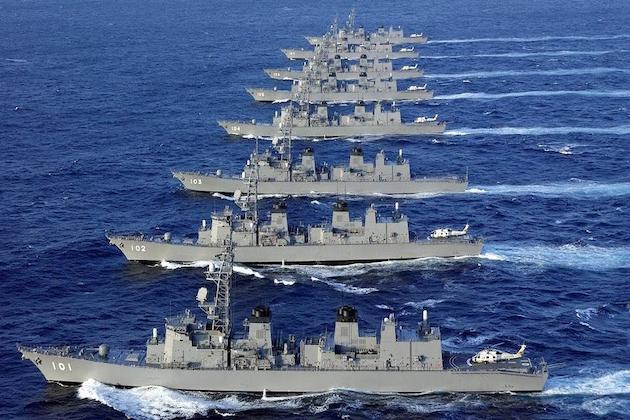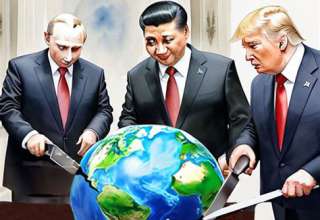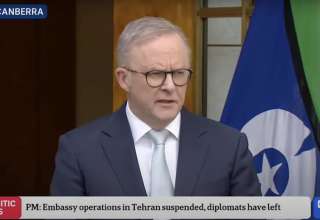By Richard Stone
Economic forecasting of the dominant players in the Indo-Pacific has revealed a significant challenge to traditional US-led hegemonic positions over the next decade and the future.
The relative economic decline of Japan will have far-reaching implications for US foreign policy and global alliance; Australia has not fared a great deal better.
The problem has already been, and is likely to continue to be, accompanied by a military build-up, increased diplomatic hostilities and the ever likely threat of ‘real-war scenarios’.
During mid-March a major economic forecast together with associated defence and security provision was placed in mainstream media as a prelude to increased military spending by Canberra. (1) A statement from Japan’s former ambassador to Indonesia, Professor Masafumi Ishii, noted that India was forecast to surpass Japan in economic terms during the next decade; Indonesia, likewise, was forecast to become the world’s fifth largest economy in the 2040s. (2)
Such forecasting was designed to send shock-waves into the heartlands of the Pentagon.
Japan’s economy has oscillated between being moribund and stagnant for decades and generations. Its displacement by China as the word’s second largest economy was heralded by the US as a threat to traditional hegemonic diplomatic positions. The changing balance of forces is now set to swing still further away from the present US leadership position.
The economic forecast also included reference to the position given Japan by Pentagon military planners: the US-Japan alliance has been upgraded to a global alliance whereby it is already a central hub for the co-ordination of US foreign policy through regional allies. (3) It has been marked by Tokyo reinforcing ‘collaboration with as many countries as possible to counter unilateral changes to the status quo and ensure Japan’s own security’. (4)
Australia, likewise, remains a central hub for ‘US interests’ in the southern part of the region.
And it has not been difficult to establish evidence of a massive wave of US-led militarism
taking place with the two hubs.
In Japan a large increase in the defence budget has also included preparations for war with China. Leaked documents recently revealed moves by Japan’s Ministry of Defence to renovate 23,000 facilities on about three hundred military bases. With costs in excess of $44.5 billion the country is upgrading allocation of government underground control centres in preparation for nuclear, biological and chemical attacks. (5)
The upgrades also include a large network of fifty low earth orbit satellites. (6)
Last month Japan’s Prime Minister, Fumio Kishada, also ordered four hundred US-made Tomahawk cruise missiles scheduled for delivery during the next twelve months; the weapons have an estimated range of at least 1,600 kms, indicating their intended use is for precision and strategic targets inside China. (7)
In Australia, a recent statement from Northrop, a major part of the US military-industrial complex, noted, US-Australia arms sales, ‘opened up multi-billion dollar opportunities for two-way investment between the US defence industrial base and Australia’, leave little to the imagination of the shape of things to come. (8) Military equipment already listed has included the delivery of long-range capabilities for Australia; costed at $333 million, three Triton MQ-4C surveillance drones for intelligence-gathering have an estimated range into the most northern parts of the region, well away from Australia’s usual areas of strategic considerations in the southern part. (9) In fact, the range extends to areas of US fleet boundaries and the beginning of island chains used for Pentagon military planning. (10)
These developments have also been accompanied by the Pentagon announcing their intention to ‘tap private capital’, to finance enhanced intelligence facilities with specific reference for cyber-space. (11) So much for official White House military budgets.
It has already been noted that, ‘recent polls … in Japan have found … public opinion hardens when questions turn to how the new capabilities will be paid for’. (12) Questions, elsewhere, in Australia have yet to be given credible answers about the massive outlays in public finance needed for the country to continue to follow US-led military planning and the defence and security of ‘US interests’. The submarine issue is still far from being effectively resolved; nuclear powered submarines, which the Pentagon insist Canberra finance, have a far greater range and are, therefore, more likely to be deployed far from Australia’s shores.
It also remains a sad fact of life for most Australians that the GDP of our small economy has declined in relative terms for decades; it will eventually sink to zero growth sometime during the next decade. Governments will then have increased difficulty raising revenue, while still burdened with a huge defence budget not designed specifically for Australian defence and security provision.
The military build-up and increased diplomatic hostilities with China, furthermore, have increased the likelihood of ‘real-war scenarios’ taking place: they have not, do not, and cannot, make a world a safer place;
We need an independent foreign policy!
1. See: Japan muscles up to the neighbourhood bully,
The Weekend Australian, 11-12 March 2023.
2. Ibid.
3. See: The reasons behind Washington’s push for GSOMIA.,
Hankyoreh, 12 November 2019.
4. Weekend Australian, op.cit., 11-12 March 2023.
5. See: Japan Press Weekly, 25-31 January 2023, and, 1-7 March 2023.
6. See: The Asahi Shimbun, 15 November 2022.
7. Weekend Australian, op.cit., 11-12 March 2023.
8. US defence giant targeting multibillion-dollar deals,
The Weekend Australian, 25-26 March 2023.
9. Ibid.
10. U.S. seeks new Asia defences,
The Wall Street Journal, 24-26 August 2012.
11. Pentagon woos tech firms in arms race,
The Australian, 28 March 2023.
12. Weekend Australian, op.cit., 11-12 March 2023.








